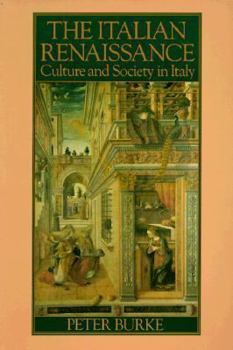The Italian Renaissance: Culture and Society in Italy
Select Format
Select Condition 
Book Overview
In this brilliant and widely acclaimed work, Peter Burke presents a social and cultural history of the Italian Renaissance. He discusses the social and political institutions that existed in Italy... This description may be from another edition of this product.
Format:Paperback
Language:English
ISBN:0691028389
ISBN13:9780691028385
Release Date:August 1987
Publisher:Princeton University Press
Length:296 Pages
Weight:1.20 lbs.
Dimensions:9.0" x 6.0" x 0.8"
Customer Reviews
2 ratings
An Introduction to Renaissance Scholarship
Published by Thriftbooks.com User , 17 years ago
Burke's `The Renaissance' is an historical primer with a twist. This is a short historiographical study that covers the usual Renaissance topics (politics, war, art, politics, religion, money, and politics) but is organized around an unconventional interpretation: namely, that the Renaissance was not strictly an Italian phenomenon, nor was it a clean break with the medieval past. Burke's interpretation (not entirely his, not entirely original) is that the Renaissance was more a `movement' than a `period'--an "attempt to revive antiquity" in art, politics, science, etc. As a result, suggests Burke, "almost every other characteristic attributed to the Renaissance can be found in the Middle Ages, to which it is so often contrasted" (p. 57, 2nd ed). In short, Burke downplays the traditional interpretation (begun over 150 years ago with Jacob Burckhardt) that the Renaissance heralded the rise of the individual and of reason (in a word, modernity) following a millennium of Dark Age stultification. Burke is the author of the very readable `The Italian Renaissance' (a solid introduction to this `movement'), as well as the superb introductory essay to the Penguin edition of Jacob Burckhardt's classic `The Civilization of the Renaissance in Italy'. 'The Renaissance' discussed here is a mere 80-odd pages; for a book this brief, which requires a clarity obtained not by length but by focus, he is the right scholar for the job. For that reason this work is useful as a first step, or a refresher, to the larger world of Renaissance scholarship; it offers the professional and amateur student of history an assessment of scholarly interpretations of the period (or `movement', whichever you prefer), as well as an alternate view of the significance of the Renaissance.
Includes Leonardo's 10 Year Guarantee!
Published by Thriftbooks.com User , 21 years ago
I sometimes get a bit nervous when I buy a book written, supposedly, for the general public by an academic. Is the book going to be written in "normal" English, or am I going to be bombarded by jargon and a clunky style? Happily, Peter Burke appears to believe in "plain-speaking". He also has a sense of humor, which helps. Additionally, he doesn't go off the deep end when coming to conclusions. He is prudent and cautious. If he can't say something definitive, if statistical or other types of evidence just aren't there, he isn't afraid to tell you so. Mr. Burke attempts to explain why the Renaissance happened in Italy and why it started when it did. This leads to the importance of the city-states, such as Florence, Milan, Venice, etc. Artists and sculptors oftimes were the children of craftsmen, and the city-states were populated by many craftsmen. Humanists and scientists were usually the children of "professional" people, and were educated at universities. Again, professionals and universities tended to be found in or near urban centers. Why did Italy have so many city-states? Because, during the period of the Italian Renaissance, Italy was a natural trade center.....right between the Middle East and Northern Europe. This created wealth, which led to the city-states, which also led to new sources of patronage, as the new merchant class looked for ways to spend their money and impress each other. When the Atlantic trade routes opened, and also after the Portuguese led the way around the Cape of Good Hope, Italy lost its place as the "hinge" of trade. Of course, I am greatly simplifying Mr. Burke's arguments, as they are much more complex and nuanced. But, I think I am giving you the general drift. In any case, what makes the book really interesting is that Mr. Burke grounds his theories in the everyday. He talks very specifically about painters, sculptors, architects, musicians, writers, etc. He tells you how they got their training, who they worked for and who called the shots......patron, artist, or both. The "case histories" are both fascinating and funny. Some examples? "More precise evidence about the relative importance of patrons and artists and the expectations of both parties is provided by the scores of surviving contracts....Contracts often specified that the materials employed be of high quality.....Leonardo's contract for "The Virgin Of The Rocks" gives a ten-year guarantee; if anything was to need repainting within that period, it was to be at the expense of the artist. One wonders if Leonardo gave a similar guarantee in the case of his flaky "Last Supper". (I can just see the author delivering this line in a lecture, with a deadpan expression!) This was also a time when the status of the artist was in flux. Before the Renaissance the artist was considered to be just another craftsman in the employ of a "great" man or lady. But as the city-state grew in importance, and as the merchant and craftsman grew in importance, the status of






